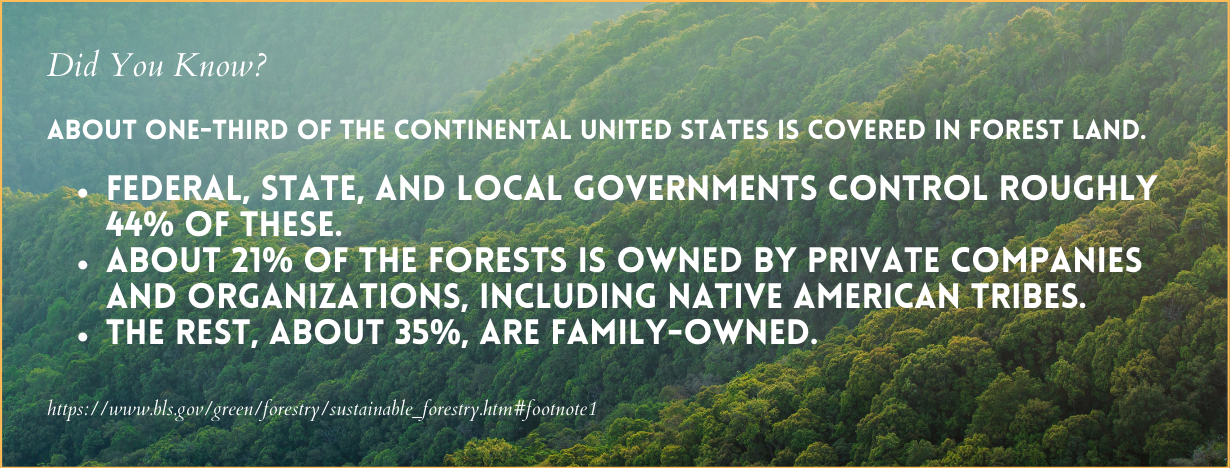Forestry is an important part of overall environmental conservation. Life on Earth couldn’t exist without trees and other plants, so it’s vital that forests continue to thrive and be healthy.
Trees are also beautiful parts of the landscape, and they add visual interest in both urban and rural areas. Learning about forestry can lead to a satisfying career, but it’s also valuable even if you don’t decide to make a living in this field.

Trees
Trees offer a variety of benefits to the environment and to humans. Trees can help stop soil erosion because they absorb large amounts of rainwater. Trees provide shade during the summer, helping to reduce the need for air conditioning.
Trees also protect buildings from heavy rain and winds. Mature trees reduce air pollution and help purify the air by producing oxygen. Some trees produce nuts, fruits, and medicines, and they serve as homes for wildlife.
Overuse and mismanagement of trees, also known as deforestation, have led to shortages of trees. Humans use trees for many purposes, such as making paper and building materials. However, it’s important to plant new trees when using trees.
Unfortunately, even when new trees are planted, mature trees take many years to grow. Without proper management of our forests, future generations may not have enough trees.
Soil and Water
Every part of the environment affects the other parts, either negatively or positively. A healthy forest environment needs healthy soil for growing and a continuous source of clean water. Fertile soil supports plant and tree roots and provides nutrients for them to grow.
Soil erosion is a major issue that causes a decrease in land quantity and quality, which is known as land degradation. A significant loss of fertile land area has had a big impact on farming in many countries.
Because trees help minimize water and wind erosion of the soil, forests help conserve soil. Forest soil can also absorb moisture effectively, which is important for water conservation.
Animals and the Forest
Many animals live in forests around the world, and they need trees to maintain their homes. Even animals that don’t live in forests often use them as protective corridors as they migrate.
By conserving forests, humans are also helping the animals that need the trees to live. Trees provide shelter and food for animals. Animals also help trees to thrive by spreading seeds far and wide. This propagates new trees and helps to fertilize the soil.
Birds and the Forest
Birds also need forests as their habitats. Healthy forests have different types of vegetation, each of which is important for birds. Near the ground, birds can hide from predators in a thick understory. At the top of a forest, the canopy varies between being open and closed, and different birds live in these specific areas.
Even dead trees are important for birds; they have holes for shelter, and insects feeding on decayed wood are food for birds. Gaps between trees allow new seedlings to germinate and grow. Selective thinning of trees is an important way to make forests better for birds because this improves biodiversity and makes habitats better.
Careers in Forestry
Earning a forestry degree provides a variety of career options. A forester may work directly with conservation, land rehabilitation, and land management organizations. These experts often take on forestry projects such as planting new trees and monitoring wildlife habitats.
Other careers include conservation scientists who help protect the environment and manage forests, forest technicians who gather and analyze forest data to determine when trees need to be removed or planted, and recreation technicians who focus on creating recreational areas in forests and woodlands.
- Strategies for Tree Conservation
- Why Plant 50 Million Trees?
- American Forests: Why it Matters
- Soil and Water Conservation
- Soil and Water Conservation Measures for Agricultural Sustainability
- Forest Habitats
- Ten Things You Can Do to Save Forests
- We All Need Healthy Forests
- Conserve and Enhance Wildlife and Fish
- Saving Endangered Animals by Saving Forests
- Seven Ways Wildlife Supports Healthy Trees and Forests
- The Importance of Forests and How We Can Protect Them
- Cutting Trees to Save the Birds
- How Planting Trees Helped Save This Endangered Bird
- Managing Forests for the Birds
- Save Wild Forests, Save Migratory Birds
- What You Can Do With a Forestry Degree
- Forest Service Careers
- Careers in Forestry: Nature’s Office Suite
